Archive for June 2022
Three weeks ago I fitted the 12 mm ply sides to the hull and then took a week break to drive to Buderim for some minor civil engineering work at or No 3 son’s home. The break was a healthy one with plenty of exercise and fresh air and it was time for a break from sawdust and epoxy. On return to Sydney I was slowed down by a virus which was neither Covid nor Influenza A or B. Despite a negative diagnosis it was not a bug I wished on anyone so I had a quiet week confined to the boat building site.
The first of the jobs tackled was glassing in the chainplate frames with five layers of double bias of which two are over the whole frame. The frames are angled in line with the spreader angle so one side is easy to work on and the acute angle side is a big awkward. While in the epoxy glass mode I completed all the internal glass joins to get the itchy jobs out of the way. As careful as I was I failed in my endeavours to keep my clothing glass free so for comfort sake I put the glassing clothes aside and started afresh with new clothes and a resolution to be even more careful.
So far my care has worked as the glass had been trimmed and sanded successfully.


The next task was to bog in all the shelves on at least one side so that after turning the other side can be completed easily. Once the shelves were horizontal and stable it was time to prime all the bare plywood internals.


Priming the internal plywood had not been on my construction plan but the bout of continual wet weather we had earlier in the year convinced me that the bare plywood had to be primed to protect the timber from the dreaded mould that was growing in every home in NSW. Now the weather had improved greatly but once set out on the journey to prime the timber it was a journey that needed to be completed.
As well as bogging in the shelves all the bulkheads and stringers had to be filleted in with structural epoxy bog before the priming could be started.
Having decided on a fillet size I prepared a test piece to satisfy myself that the structural strength was satisfactory. Being confident I had completed all the filleting before the test piece was cured enough for the test. It passed with the plywood test piece breaking instead of the fillet.
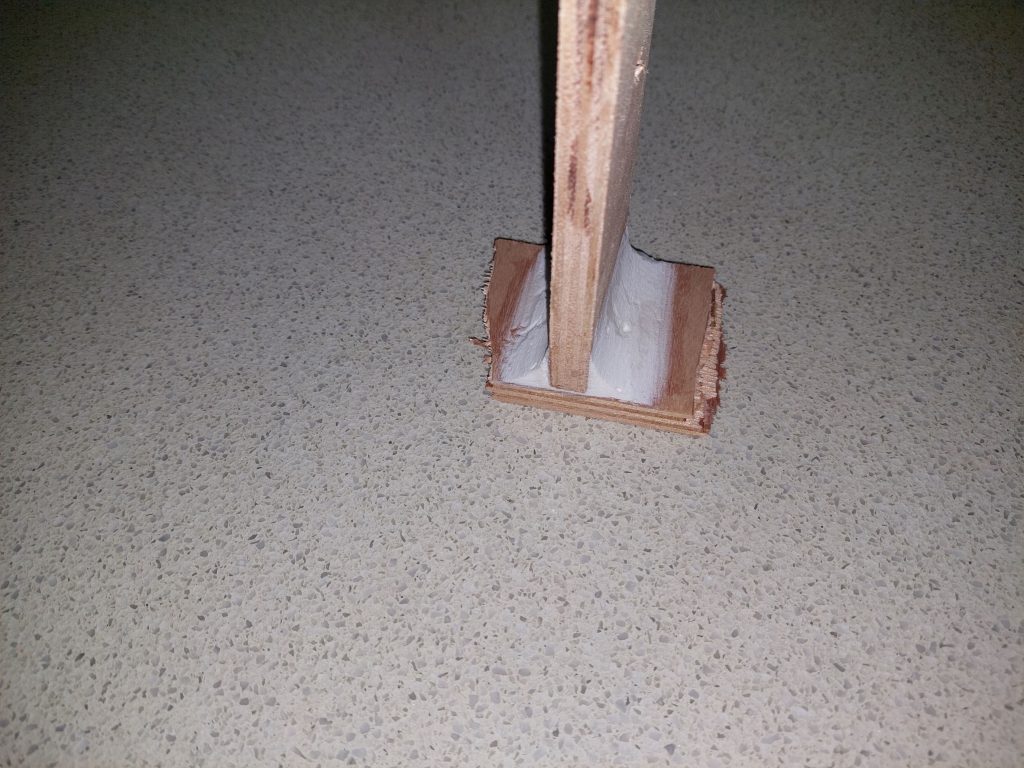
Doing structural fillets is an acquired skill. As simple as it looks it takes time to master the techniques and do the work at an efficient pace so some of my fillets are excellent and some needed a lot of post cure surgery before they were tidy enough for painting. As time progressed my speed and quality improved so that the finished job looks fairly professional.
A lot of the fillets will be hidden inside cupboards but the perfectionist in me refused to do these to any lesser standard than the ones in full display.
It takes a day to sand from the mast step to the transom on one side and then apply one coat of primer so there has been four very big days sanding and painting to get the two coats applied.


After the first coat the sanding back reveals any defects that need more preparation and the first coat brings up the wood fibres which need to be removed before the second coat is applied.
Planning ahead I prepared some of the internal ply that up to this time only a single coat of primer so that any left over primer could be used efficiently on a second coat and that has worked well with nothing wasted.
At the bow I have three bays which have the first coat of primer and are sanded back ready for their second coat. I think that is the next step and that will use up what primer I have.
Next job is to do all the packing pieces between the keel floors and the hull so that when I affix the bottom ply the internal work is complete. To be prudent there is probably two weeks work in that exercise .
We were surprised that the race was abandoned when we were all the way back to Steele Point and had only to get to a short course finish in Rose Bay which is the usual order of events in light winds. There was a good chance that the calm in Rose Bay could have persisted but we were coming down with wind.
Up to that point we had been having a wonderful afternoon with three knots of westerly wind carrying the fleet out towards the Sow and Pigs. Everyone seemed to have a turn doing well. Amanti jumped out early only to have to wait as she sailed into the doldrums first. Agrovation went South and missed the whisp of westerly that carried the fleet forward. We started near the boat and stayed south of the fleet waiting for the wind shadow from Fidelis to pass to windward. Once in clear air we accelerated to keep pace with the fleet and headed down the rhumb line. We were doing well to leeward of the fleet but in clear air so it was unsurprising that Cuckoos Nest and Crosshaven came across on starboard. We wriggled behind the starboard gybe Crosshaven and Monkey Magic and held our course for the distant mark.
Everyone seemed to have a turn at catching up but by good luck we managed to keep gapping few boat lengths on the fleet except for Amanti and Agrovation.
As the breeze swung from zero knots to a 6 knot south east we hunkered down into beating mode but keeping it fast. Being inside Amanti and Agrovation we made up a little ground and rounded just behind Amanti. Britannia came charging in from deep down south and rounded on our stern. They very promptly had their large genoa poled out to leeward and maintained a position to windward of Passion X while we were chasing down Amanti.
Then the news of the abandonment came across the radio and that was it.
As the fleet order stood Britannia would have been clear leader with Passion X a good prospect for a second on handicap but it was not to be.
In the tug of war between adding more plywood panels towards the stern and finishing the ply that was already installed the extra plywood won out.
It was not a hard choice as the weather suited adding more sheets of plywood and once I got into a routine the extra six sheets to finish the sides back to the stern progressed well.
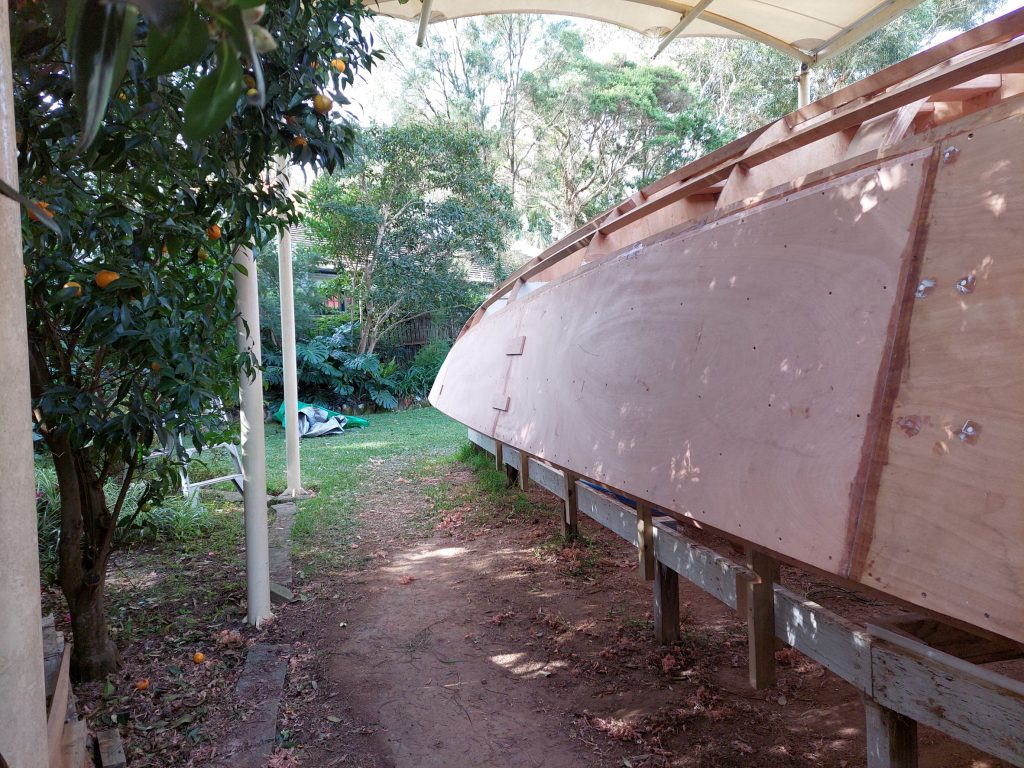
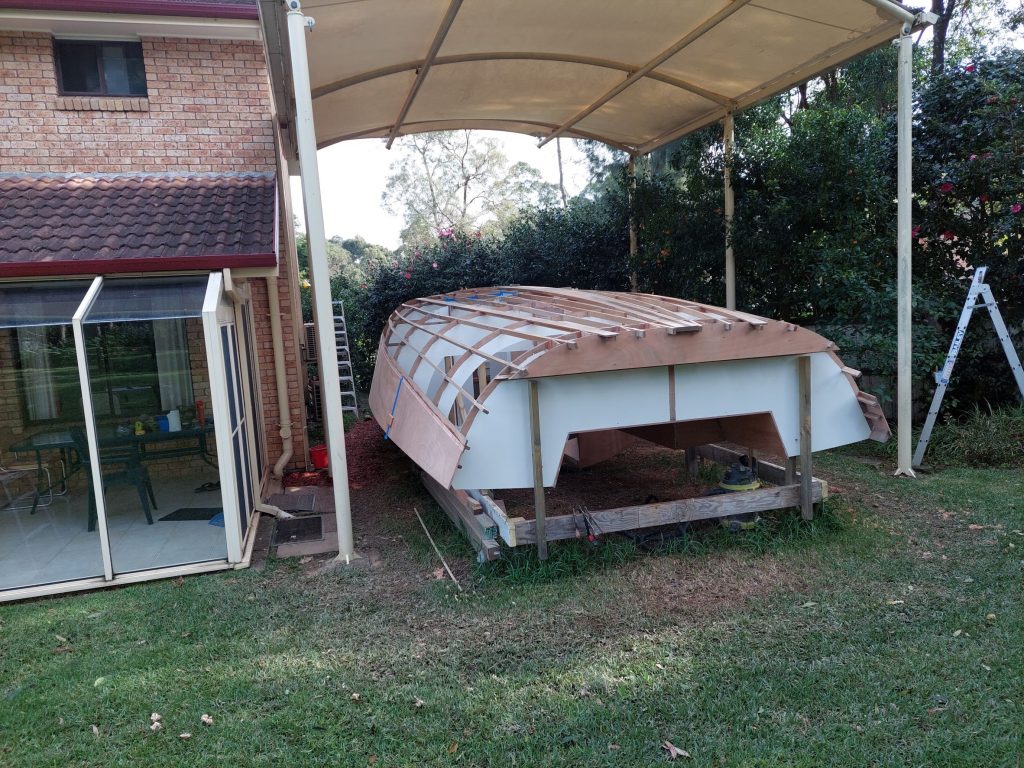
While it appears that a lot of progress has been made the appearance is deceptive. The hull had been prepared for the ply sheets many weeks ago while I was waiting for construction drawings for the keel floors. Likewise I had already cut and fitted ten shelves so gluing in the six shelves in the quarter berth area was a quick task. Nevertheless i did recheck all the stringers and did take a few plane strokes off here and there. Finally all the surfaces to be glued were sanded.
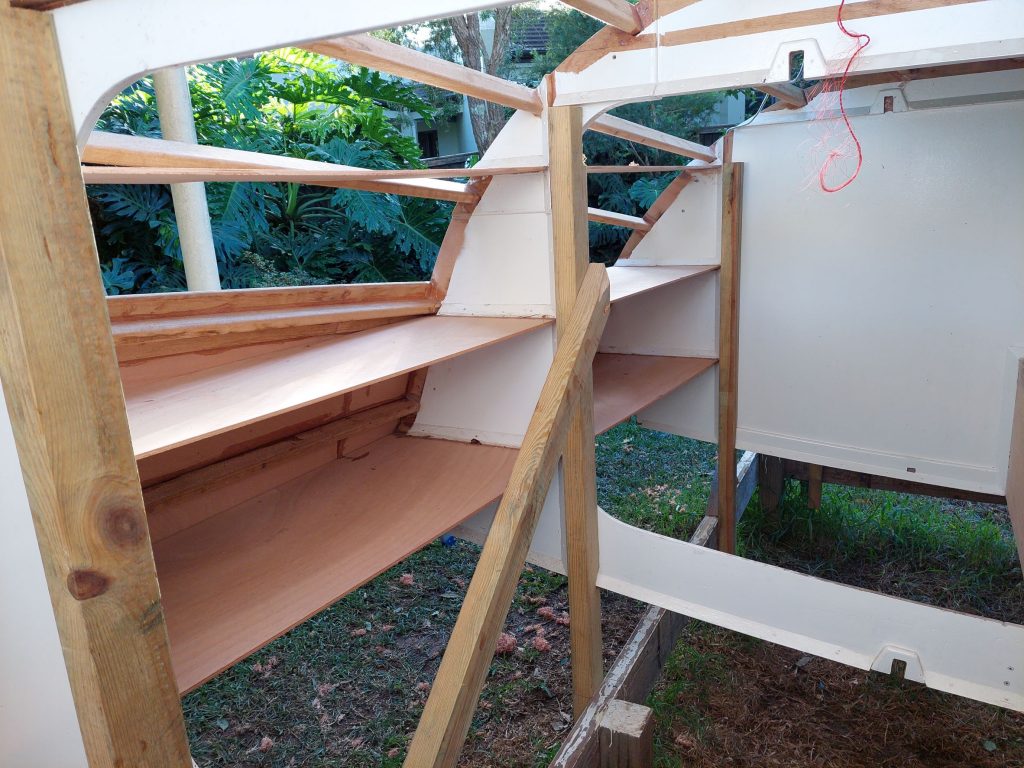
When the Wednesday racing at RANSA was cancelled due to the strong wind warning I used the time to advantage and fixed more panels. It was helpful that the two sided are identical so that once one side was trimmed to size it was a template for the other side.
By Thursday I had only one sheet to fit and that was already cut to size, marked with the stringer positions and had the edge rebated at the tangent chine.
Fitting the sheets to the hull was not without drama with the occasional shower threatening but with help from Elaine the panels were all fixed to the hull.
The balance of Thursday was spent with some finishing tasks and priming a lot of bare plywood in the quarter berth and cockpit locker areas. This priming is bringing forward a lot of finishing and I am confident that the road to completion is shortening with every coat of primer.
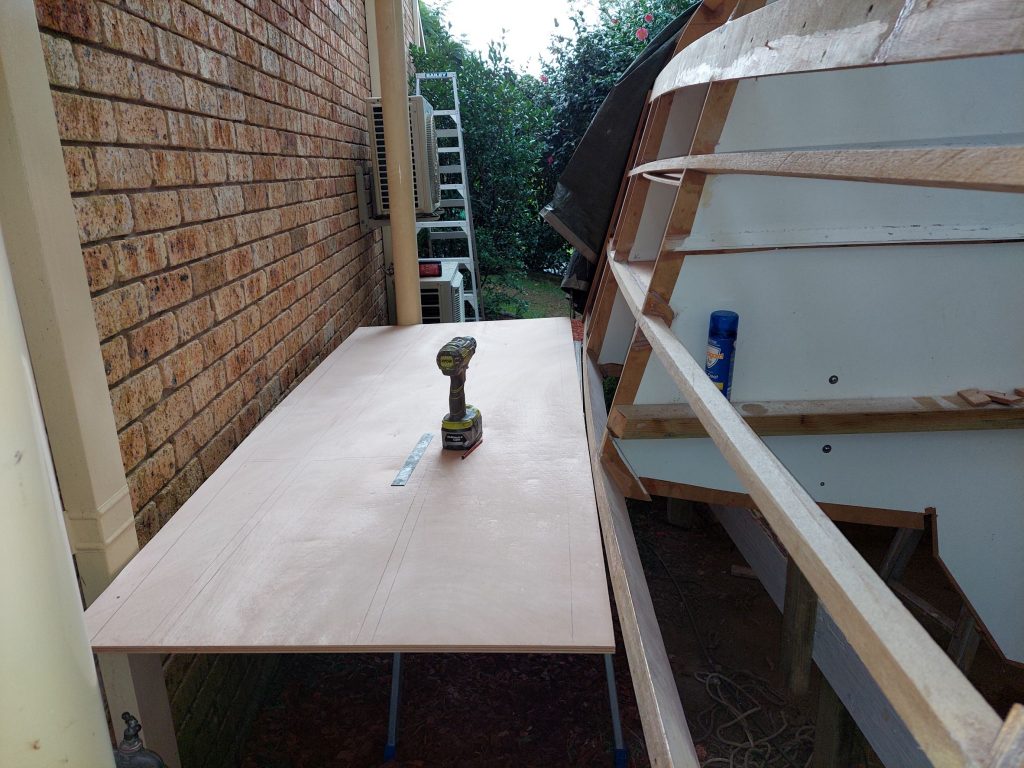
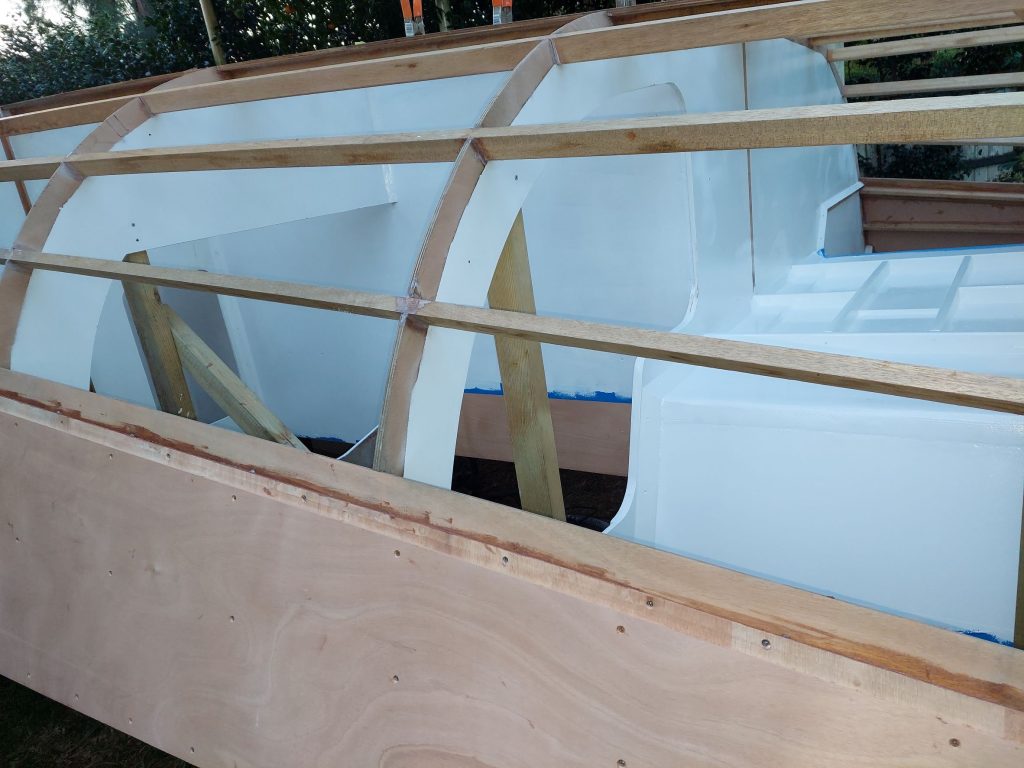
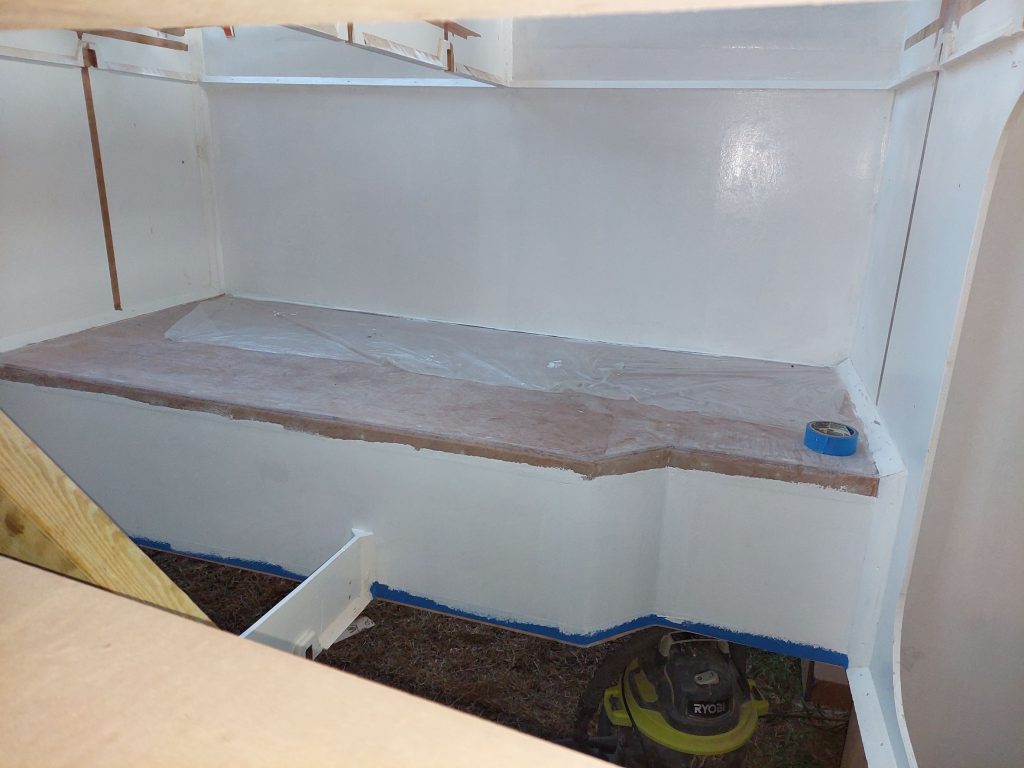
In contrast to the appearance of speed earlier in the week today was a slow one with careful preparation of the chainplate frames for glassing to the external plywood. I am being careful to remove any cured epoxy or at a minimum ensure that all the surface gloss is removed and well sanded surface is presented for gluing. In all there are five layers of glass to go over the join of the chainplate frames to the hull and today I managed only three layers on one side of one chainplate. On the bright side all the connections have been prepared so it is just a lot of glassing to go.
I am pushing forward with the glassing of the chainplate frames so that I can prime the settee locker area and work towards the stern priming the interior of all the plywood panels installed this week.